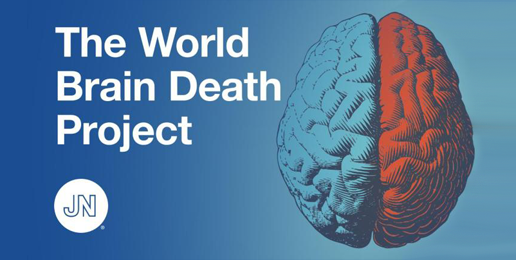
THE HISTORY OF BRAIN DEATH
In December of 1967, the first successful heart transplant was performed in South Africa by Dr. Christian Barnard. At that time, there were no guidelines for the diagnosis of death for beating heart donors.
In September of 1968, the Report of the Ad Hoc Committee of the Harvard Medical School to Examine the Definition of Brain Death was published with the purpose of defining irreversible coma as a new criterion for death.
This was done for two stated reasons:
1.) “Improvements in resuscitative and supportive measures have led to increase efforts to save those who are desperately injured. Sometimes these efforts have only partial success so that the result is an individual whose heart continues to beat but whose brain is irreversibly damaged. The burden is great on patients who suffer permanent loss of intellect, on their families, on the hospitals and on those in need of hospital beds already occupied by these comatose patients.“
2.) “Obsolete criteria for the definition of death can lead to controversy in obtaining organs for transplantation.” (All emphasis added)
This report was quickly accepted by many and in 1968, the Uniform Anatomical Gift Act was passed in the US as a regulatory framework for the donation of organs, tissues and other human body parts. The Act allowed the donation of whole or part of a human body to take effect upon or after the death of the donor.
The Uniform Declaration of Death Act (UDDA) was drafted in 1981 by a President’s Commission study to brain death and approved by both the American Medical Association (AMA) and the American Bar Association (ABA). It was intended to provide a model for states to emulate.
It offered 2 definitions of when a person could be declared legally dead to align the legal definition of death with the criteria largely accepted by the medical community:
1.) “Irreversible cessation of circulatory and respiratory functions (the traditional definition of death); or
2.) Irreversible cessation of all functions of the entire brain, including the brain stem (brain death)” (Emphasis added)
The UDDA in some form has since been adopted by all U.S. states and the District of Columbia.
However, in the June 2020 issue of the American Journal of Bioethics, the well-known lawyer/ethicist Thaddeus Mason Pope wrote about a current effort “to revise the Uniform Determination of Death Act (UDDA) to assure a consistent nationwide approach to consent for brain death testing.” (Emphasis added)
Why just consent to brain death testing?
According to Mr. Pope:
Right now, a patient might be legally dead in Nevada, New York, or Virginia (where consent is not required). But that same patient might not be legally dead in California, Kansas, or Montana (where consent is required and might be refused). (Emphasis added)
Instead, Mr. Pope proposes adding this to the Uniform Determination of Death Act (UDDA):
Reasonable efforts should be made to notify a patient’s legally authorized decision-maker before performing a determination of death by neurologic criteria, but consent is not required to initiate such an evaluation. (Emphasis added)
Mr. Pope states that typically, the Uniform Law Commission (ULC) follows a four-step process to change a law but notes that the Healthcare Law Committee has already skipped the first three steps and is ready for drafting the new language in the fourth step.
Ironically, there was a case last year in Michigan where the parents of a teenager pushed for a Bobby’s Law after their son was taken off life support after being declared brain dead despite their objections. The law would “require a minor’s parents to consent to withhold or withdraw life-sustaining treatment or to give do-not-resuscitate orders before medical professionals could end life support for a juvenile” and also allow the parents to defer an apnea test (taking the person off a ventilator to see if the person is able to breathe on his or her own) required to determine brain death. (Emphasis added)
THE WORLD BRAIN DEATH PROJECT
In an August 3, 2020 article in the Journal of the American Medical Association (JAMA) titled “Determination of Brain Death/Death by Neurologic Criteria- The World Brain Death Project” , the authors state that due to “inconsistencies in concept, criteria, practice, and documentation of brain death/death by neurologic criteria (BD/DNC) both internationally and within countries”, there is a need to “formulate a consensus statement of recommendations on determination of BD/DNC”. (Emphasis added)
In an August 3, 2020 Medpage Today article “Brain Death: What Does It Mean?” on the World Brain Death Project, the writer notes that the “guidelines recommend that consent not be required for apnea testing because of concerns over prolonged somatic support” while quoting a doctor who disagreed:
Ostensibly, families should be asked to provide consent because the apnea test may lead to cardiovascular collapse in some patients, classifying it as procedure with risk, (All emphasis added)
MY JOURNEY TO DISCOVER THE FACTS ABOUT BRAIN DEATH
Back in the early 1970s when I was a young intensive care unit nurse, no one questioned the new innovation of brain death organ transplantation. We trusted the experts and the prevailing medical ethic of the utmost respect for every human life.
However, as the doctors diagnosed brain death in our unit and I cared for these patients until their organs were harvested, I started to ask questions. For example, doctors assured us that these patients would die anyway within two weeks even if the ventilator to support breathing was continued, but no studies were cited. I also asked if we were making a brain-injured patient worse by removing the ventilator for up to 10 minutes for the apnea test to see if he or she would breathe since we knew that brain cells start to die when breathing stops for more than a few minutes.
I was told that greater minds than mine had it all figured out so I shouldn’t worry.
It was years before I realized that these doctors did not have the answers themselves and that my questions were valid.
I discovered that some mothers declared “brain dead” were able to gestate their babies for weeks or months to a successful delivery before their ventilators were removed and that there were cases of “brain dead” people like Jahi McMath living for years after a diagnosis of brain death or even recovering like Zack Dunlap.
If the legal definition of brain death is truly “irreversible cessation of all functions of the entire brain, including the brain stem”, these cases would seem to be impossible.
CONCLUSION
The World Brain Death Project is riddled with potential problems in establishing a worldwide consensus on brain death criteria and testing using a “set of criteria that satisfies the lowest acceptable standard for practice”. (Emphasis added) And changing the US Uniform Determination of Death Act to supersede states requiring consent before brain death testing will not inspire trust in the healthcare system or the law.
Personally, I will not sign an organ donor card or allow my organs to be taken by donation after cardiac death (DCD), a new category of severely brain-injured people who are not brain dead but who are on ventilators (breathing machines) and considered hopeless in terms of survival or predicted “quality of life”. The ventilator is removed and the patient’s heart is expected to stop. (However, a 2016 study showed that 27% of potential donors did not die within the window specified for organ recovery.)
Instead, my family knows that I am willing to donate tissues like corneas, skin, bones, etc. that can be ethically donated after natural death.
It is vitally important that everyone understands all the facts before signing an organ donor card.
And we all should demand transparency and rigorous medical ethics from our healthcare system.
This article was originally published at NancyValko.com.




















